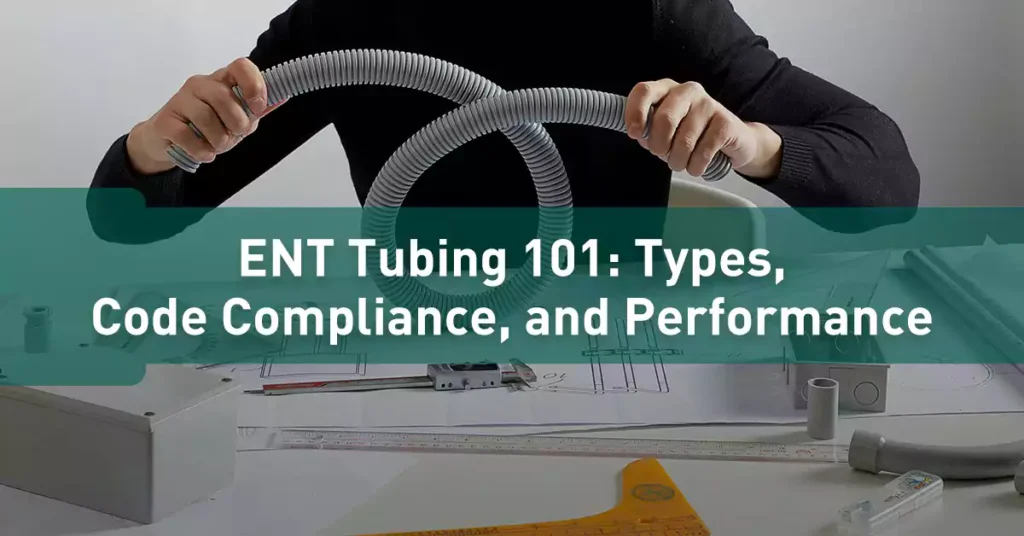
Table des matières
In electrical installation systems, conduits play a crucial role in protecting and routing electrical wiring, ensuring safety and performance across various applications. Among the many types of conduits available, Electrical Nonmetallic Tubing (ENT) stands out for its flexibility and ease of use. ENT tubing has become a popular choice in residential, commercial, and even industrial projects due to its lightweight nature and durability.
This article delves into the essential aspects of ENT tubing, providing a comprehensive overview that includes its definition, key standards, and performance requirements. By exploring the UL and AS standards that govern ENT tubing, comparing these standards, and examining the advantages and disadvantages, this article will equip you with valuable knowledge. You’ll also learn about ENT’s applications, installation guidelines, and fittings, as well as receive insights into how this type of tubing integrates with emerging technologies like renewable energy and automotive conduit systems. Finally, the article discusses current trends and future innovations in the field, ensuring you have a thorough understanding of ENT tubing’s role in modern electrical infrastructure.
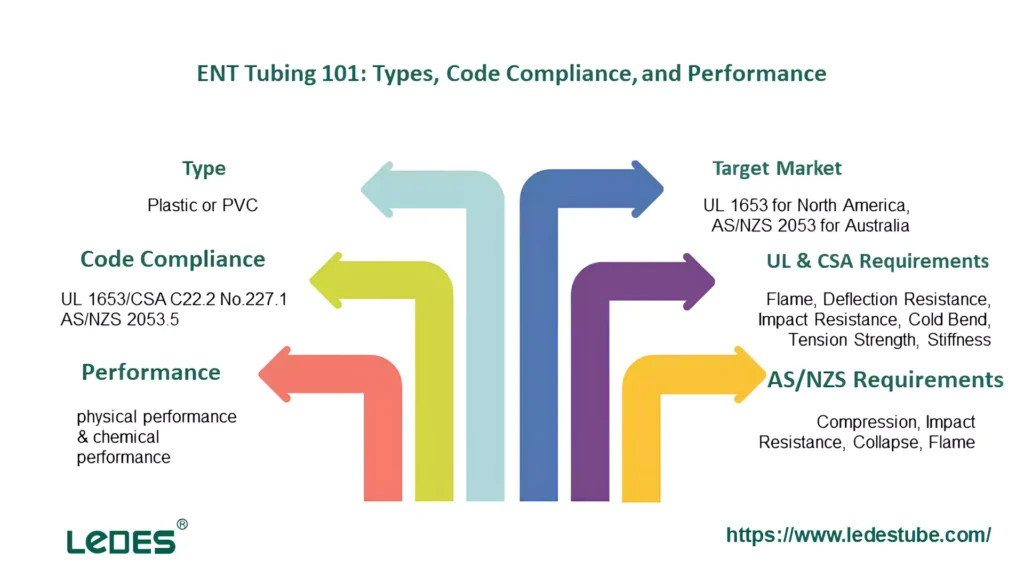
Partagez cette image sur votre site
Tubes électriques non métalliques (ENT) is a flexible, lightweight conduit used to protect and route electrical wires in both residential and commercial applications. Made from polyvinyl chloride (PVC) or other flame-retardant plastics, ENT is designed to be easily bendable and is resistant to impact, moisture, and chemical exposure. ENT is primarily utilized in environments where a rigid conduit would be cumbersome or challenging to install, offering an adaptable solution for routing electrical conductors through walls, ceilings, and floors.
There are many types of nonmetallic tubing for using in different countries and regions, in this article we will mainly introduce two standards tubing, and get to know the specific safety and performance criteria requirements that they must meet outlined in various national and international standards.
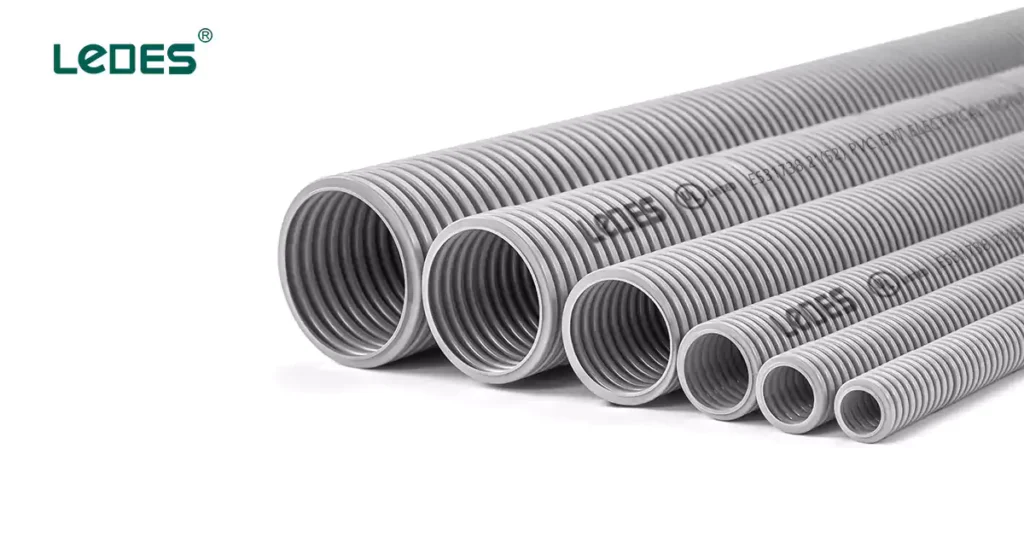
For ENT, the United States and Canada share the same standard, UL 1653/CSA C22.2 No.227.1, these two standards share the same requirements for ENT conduit, just some certain tests are slightly different, this standard outlines the safety and performance requirements for electrical nonmetallic tubing. UL-certified ENT must adhere to the National Electrical Code (NEC) Article 362, which specifies installation guidelines and limitations to ensure safe use in building construction.
If you would like to learn more about UL/CSA standard ENT conduit, you can read our last post on the ENT conduit guide for the USA and Canada.
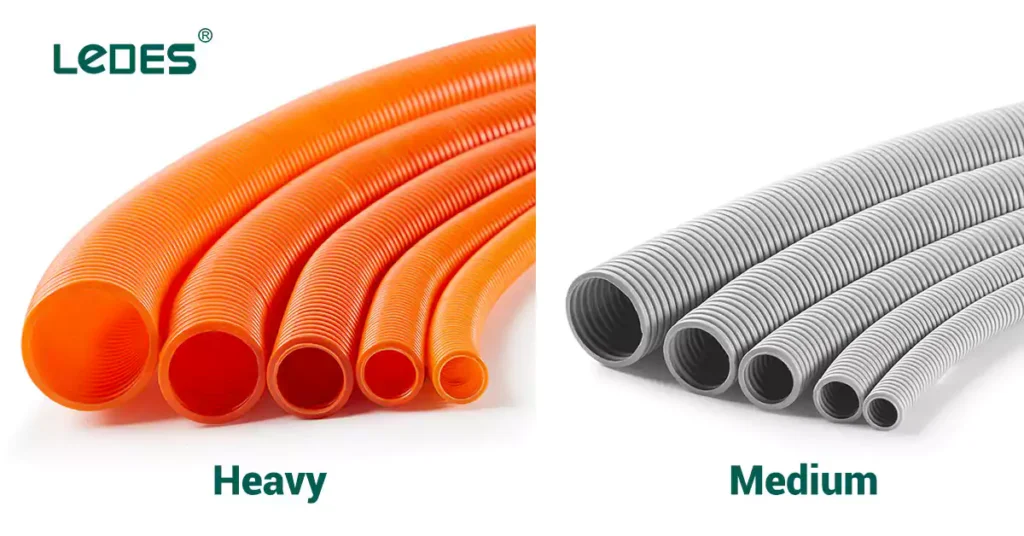
The AS/NZS 2053.5 standard is used in Australia and New Zealand for non-metallic conduits and fittings. Different from the ENT in UL1653, in order to meet different needs, in the AS/NZS standard corrugated conduit are divided into several grades according to different application scenarios, such as light, medium, heavy, etc., and their various performance strengths are also different. This standard includes requirements for thermal properties, mechanical strength, and resistance to environmental factors.
UL1653 has specified all the dimension and performance requirements for ENT, here are some most important aspects you should know:
There are two tests of flaming in UL1653, FT4 test is optional, but it is favored by most people that if the ENT conduit passed FT4 test. Here are some information for these two tests:
- Vertical Flame Test (500 W burner): In clause 7.2, UL1653, the vertical flame test assesses the conduit’s performance when subjected to direct flame exposure under controlled conditions. This test is conducted by positioning a sample of the conduit vertically and applying a 500-watt flame at the base for a specific duration. The primary objective is to observe whether the flame self-extinguishes after the source is removed and to ensure that the flame spread does not exceed specified limits.
- Flame Test in Cable Trays (FT4): The FT4 flame test is specified in clause 7.3, and the test method is according to CSA C22.2. No.211.0. The test simulates conditions found in cable trays, where wiring and conduits are often grouped closely together. This test assesses whether the conduit can prevent flames from spreading across bundles of cables and conduits under fire exposure. The setup involves placing conduit samples in a cable tray configuration and applying a substantial flame source to test flame spread under more challenging conditions.
The requirements for this test are stringent. The test determines whether the tubing can resist flame spread when exposed to high-intensity flames for a set period, and it must meet criteria for self-extinguishing and limited char length. Passing the FT4 test signifies that the ENT tubing provides reliable fire resistance in scenarios where multiple cables and conduits are present, reducing the risk of fire escalation in complex electrical systems.
Deflection resistance is a critical parameter that ensures the durability and mechanical stability of Electrical Nonmetallic Tubing (ENT) under compressive forces. Clause 7.5 of the UL 1653 standard outlines the specific procedures and conditions for testing ENT’s resistance to deflection, providing assurance that the tubing can withstand external loads without significant deformation or structural failure.
General Requirements (Clause 7.5.1):
- The test requires six samples of each trade size of ENT tubing, with each sample cut to a length of 150 ± 3 mm (6 ± 1/8 inches).
- Each sample is subjected to a specific load, varying by trade size:
16 (1/2) trade size: 4448 N (1000 lbf)
21 (3/4) trade size: 3470 N (780 lbf)
27 (1) trade size: 3380 N (760 lbf)
35 (1-1/4) and larger trade sizes: 1779 N (400 lbf)
- Canadian Specific Requirement: For the 63 (2-1/2) trade size, six samples are subjected to a load of 1334 N (300 lbf). This requirement is specific to Canada and does not apply in the United States.
Testing Procedure (Clause 7.5.3)
The procedure for testing deflection resistance is as follows:
- Initial Measurement: Measure and record the inside diameter of the ENT sample.
- Positioning: Place the sample between the platens of the compression machine, aligning the inside diameter perpendicularly to the platens.
- Application de charge : Operate the machine until the specified load for the trade size is applied.
- Measurement During Load: Stop the machine, remeasure the inside diameter, and calculate the percentage decrease in the diameter.
- Observation: Monitor the sample for any signs of buckling during the test.
- Post-Test Examination: After releasing the load, remove the sample and inspect it for any cracking or damage.
The impact resistance of Electrical Tubing is an essential performance characteristic, particularly for installations where physical force or environmental conditions may challenge the integrity of the conduit. The UL 1653 standard outlines specific tests to assess the impact resistance of ENT, ensuring that it can withstand mechanical stress without significant damage. The impact test is detailed in clause 7.6 of UL 1653, which provides clear guidelines for how samples are prepared, tested, and evaluated.
Exigences générales :
- ENT samples must be tested under controlled conditions at a temperature of -20 ± 1°C (-4 ± 1.8°F). This low-temperature requirement simulates conditions where the conduit might be exposed to cold environments, ensuring it maintains its structural properties in such scenarios.
- The impact test applies an energy force of 2.7 Joules (2.0 ft-lbf) to each sample to evaluate its resistance to breakage or deformation.
- Each test sample must be cut perpendicular to its longitudinal axis, with a required length of 150 ± 6 mm (6 ± 1/4 inches) to standardize testing.
- No more than two out of ten samples tested shall show cracks, chips, or ruptures on the inside or outside of the sample.
The ability of ENT to pass these stringent impact tests supports its use in both standard and challenging applications, confirming that it remains functional and effective even under conditions that may induce mechanical stress.
The cold bend test is an essential evaluation to confirm that Electrical Nonmetallic Tubing (ENT) can maintain its flexibility and structural integrity when bent at low temperatures, simulating harsh environmental conditions. This ensures that the conduit will not crack, chip, or rupture when exposed to bending stress in cold climates. The UL 1653 standard specifies the cold bend test under clause 7.7, detailing procedures and requirements for conducting this test.
Clause 7.7 – Test Description:
- The cold bend test requires six samples of each trade size of ENT tubing to be tested. These samples must be conditioned to simulate real-world cold temperature exposure.
- Each sample is bent 360° around a mandrel with a specified radius, which varies depending on the trade size of the ENT. The mandrel radius specifications are listed in Table 2 of UL 1653, ensuring standardized testing for various tubing sizes.
- Before bending, both the samples and the mandrel are conditioned at a temperature of -20 ± 1°C (-4 ± 1.8°F) for 4 hours. This conditioning ensures that the material reaches and maintains a uniform low temperature throughout the testing period.
- The bending process is conducted while the samples and the mandrel are still at this low temperature, ensuring the test accurately reflects the tubing’s performance under cold environmental conditions.
Test Requirements: During the test, the samples must be bent smoothly around the mandrel without causing damage. Specifically, no sample should crack, chip, or rupture during or after the bending process.
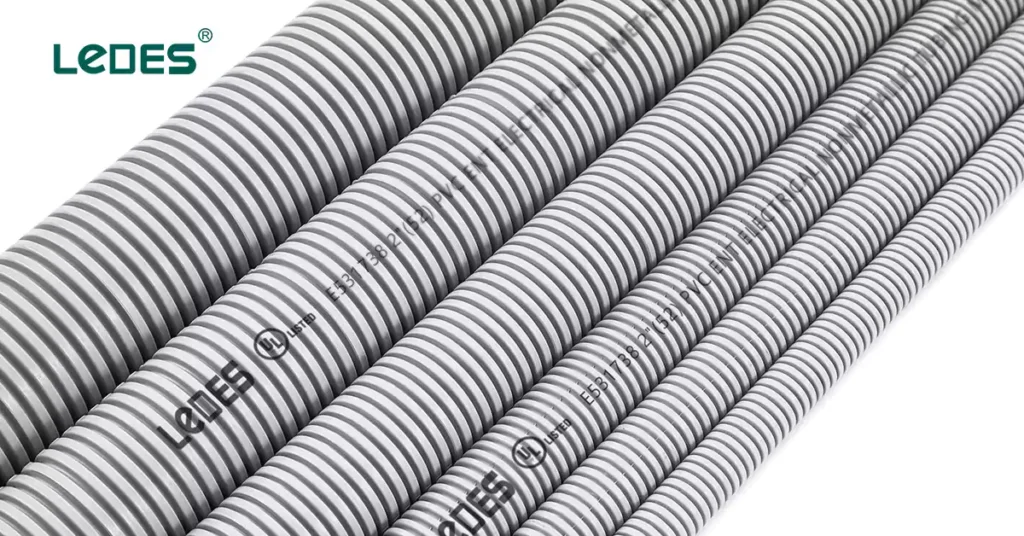
The tension test outlined in clause 7.8 of UL 1653 evaluates the ability of Electrical Nonmetallic Tubing (ENT) to withstand axial forces without breaking. This test ensures that the tubing can endure mechanical tension stresses that may occur during installation or in service without compromising its structural integrity.
Testing Application:
- For smaller trade sizes, 16 (1/2) and 21 (3/4), a 90 kg (200 lb) mass is attached to one end of the conduit to create a tension force of 889 N (200 lbf). The mass is lifted off the floor by pulling on the opposite end, and the load is maintained for 1 minute.
- For larger trade sizes, 27 (1) and above, a 135 kg (300 lb) mass is used, creating a tension force of 1,334 N (300 lbf), with the same one-minute hold requirement.
Performance Criteria
The ENT tubing must withstand the applied tension force for 1 minute without breaking or showing significant structural damage. This demonstrates the conduit’s ability to handle tensile stresses during handling, installation, or use.
The stiffness of Electrical Nonmetallic Tubing (ENT) is an important property that reflects its ability to resist deformation under load. This characteristic is essential for ensuring the conduit maintains its structural integrity when installed, especially in underground applications where external forces, such as soil pressure, are present. The stiffness requirement is particularly significant in Canada and is outlined in clause 5.10 of UL 1653.
Exigence:
- Au Canada, ENT must meet a minimum pipe stiffness of 300 kPa at 5% deflection. This requirement is tested in accordance with ASTM D 2412, which specifies the standard method for determining the stiffness of plastic pipes by measuring the force needed to cause a specified deflection of the conduit.
- Aux États-Unis, this stiffness requirement does not apply. While ENT used in U.S. applications must still meet other performance and safety criteria set forth in UL 1653 and the National Electrical Code (NEC), a specific stiffness value for direct burial is not mandated.
Compression test is to ensure that the tubing can withstand applied mechanical pressure while maintaining structural integrity. It helps verify the conduit’s capability to endure external loads without compromising its protective function over electrical wiring.
Test Requirements:
According to AS/NZS 2053.5 and AS/NZS 2053.1, the conduit flexible ondulé should comply with follow requirements:
- General Objective: The conduit must demonstrate resistance to compression by not undergoing excessive deformation when subjected to a specified force.
- Deformation Limit: The critical requirement for passing this test is that the difference between the initial outside diameter of the conduit and the diameter measured while the force is still applied must not exceed 25%. This ensures the conduit retains adequate mechanical properties under stress and does not deform beyond an acceptable threshold.
Conduit | Compression force (N) |
Très léger | 125 |
Lumière | 320 |
Moyen | 750 |
Lourd | 1250 |
Very Heavy | 4000 |
The AS/NZS 2053.1 standard outlines a specific set of impact test requirements that assess the ability of the nonmetallic corrugated conduit to withstand mechanical impacts without compromising their structural integrity.
Apparatus and Test Pieces
Conditioning Chambers: Two chambers that can maintain the conduit’s maximum and minimum service temperatures with a ±2°C tolerance. These chambers are used to simulate extreme temperature conditions before impact testing.
Impact Test Apparatus: Includes a base with a steel plate and a hammer set to specified weights and fall heights.
Sponge Rubber Pad: A 40 mm thick pad under the apparatus to absorb shock.
The test is conducted on 12 lengths of conduit, each 200 mm long, or on 12 assembled fittings that include all components as they would be used in real-life applications.
Procedure for Impact Testing
- Conditioning the test piece at the maximum service temperature for 240 hours in Chamber 1.
- Transferring the test piece to Chamber 2, where it is conditioned at the minimum service temperature for at least 2 hours or until it matches the chamber’s air temperature.
- Placing the test piece on the steel base and applying the intermediate steel piece.
- Dropping a hammer of specified weight and height to simulate impact.
The weakest part of fittings is targeted for testing, but impacts are avoided within 5 mm of any socket mouth.
Mechanical property | Poids du marteau kg | Hauteur de chute mm |
Très léger | 0.5 | 100 ±1 |
Lumière | 1.0 | 100 ±1 |
Moyen | 2.0 | 100 ±1 |
Lourd | 2.0 | 300 ±1 |
Très lourd | 6.8 | 300 ±1 |
Critères d'acceptation
At least 9 out of 12 test pieces must show no signs of cracking or disintegration when visually inspected with normal or corrected vision, without magnification.
Meeting these stringent criteria ensures that nonmetallic corrugated conduits provide consistent performance and durability, maintaining their protective qualities under mechanical stress.
The collapse test is a crucial evaluation in the AS/NZS 2053 series, which confirms that the metallic tubing can withstand environmental stress without compromising its internal diameter or structural form.
Test Procedure for Tubing Collapse
- Bend the Sample:
Carefully bend the ENT tube to 90° at room temperature using the specified bending device.
- Secure the Sample:
Attach the bent tube to a rigid support with four straps, as shown in the standard’s diagram.
Remove any tools used to bend the tube.
- Heat the Sample:
Place the support with the tube into a temperature-controlled chamber.
Keep the chamber at the highest temperature recommended by the manufacturer (±2°C) for 24 hours.
- Check the Sample:
Take the support with the tube out of the chamber.
Measure the inside diameter to ensure it meets the standard’s minimum requirement.
Critères d'acceptation
The ENT sample passes the collapse test if a gauge, as outlined in the relevant part of the AS/NZS 2053 series, can successfully pass through the conduit. This verifies that the tubing has maintained its shape and internal clearance, confirming its resilience under thermal stress.
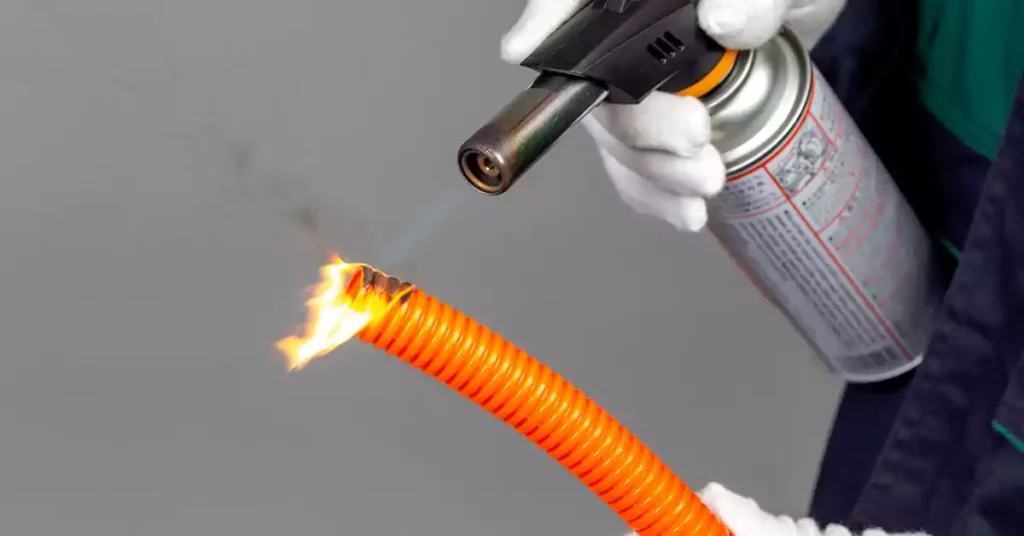
The corrugated conduit must demonstrate adequate resistance to flame propagation to be considered non-flame propagating as specified by AS/NZS 2053.5 and AS/NZS 2053.1. The flame resistance test involves the following key points:
Flame Application:
- A 1 kW flame is applied at a 45° angle to the sample, positioned 100 ±10 mm from the sample and aimed at a point 100 ±5 mm above the lower clamp.
- The flame is maintained for 60 ±1 seconds and then removed.
Test Criteria:
- The test is conducted on three samples.
- The sample passes if it does not ignite or if burning stops within 30 seconds after the flame is removed.
- The sample should show no charring or burning within 50 mm of the clamps.
- Ignition of the tissue paper beneath the sample indicates failure.
Conformité:
To comply, the corrugated conduit samples must show no persistent combustion after flame removal and no charring close to the clamps. Presence of molten material does not constitute failure unless it results in burning or charring of the sample itself.
Two primary benchmarks used for flexible nonmetallic conduit comparison are the UL (Underwriters Laboratories) standard for electrical nonmetallic tubing (ENT) and AS/NZS 2053.5, which governs nonmetallic corrugated conduits used in Australia and New Zealand. Although both conduit types serve the same fundamental purpose of protecting electrical wiring, they are tailored to meet varying requirements in terms of dimensions, strength, and performance as stipulated by their respective standards.
When comparing UL standard electrical nonmetallic tubing and AS/NZS 2053.5 nonmetallic corrugated conduit, notable distinctions arise in areas such as:
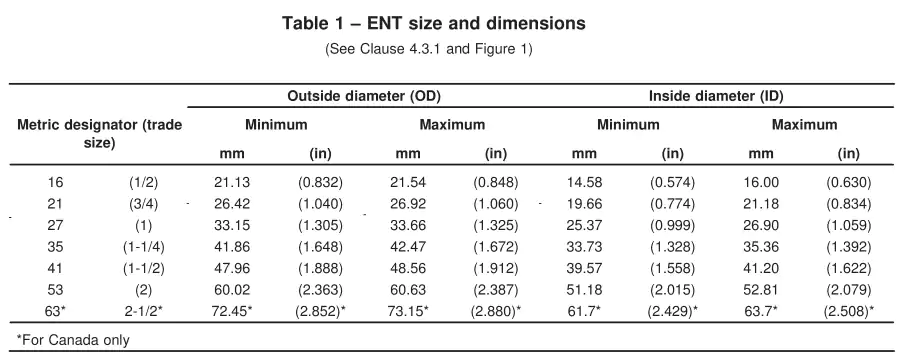
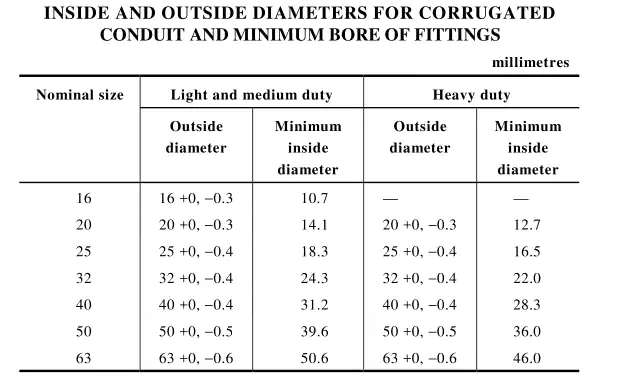
As you can see, even though they are made of the same material and have almost the same name, the size difference is huge. Even if the size is close, they are almost completely different when tolerances are taken into account.
Crush and Impact Resistance:
UL ENT: Outlines rigorous testing for crush resistance with specific load thresholds to ensure the conduit can withstand pressure without permanent deformation.
AS/NZS 2053.5 Flexible: Employs impact tests suitable for conduits used in diverse settings, with particular attention to temperature resilience and recovery after compression.
Aspects | UL1653 | AS/NZS2053 |
Test Temperature | -20 ± 1°C (-4 ± 1.8°F) | Max and min service temperatures |
Sample | 150 ± 6 mm length, cut perpendicularly | 200 mm length, 12 samples |
Impact Energy Force | 2.7 Joules (2.0 ft-lbf) | Variable (0.5 kg to 6.8 kg hammer) |
Conditioning Time | Minimum 4 hours | 240 hours at max temperature, 2+ hours at min temperature |
Number of Samples | 10 samples | 12 samples |
Critères d'acceptation | Max 2 out of 10 can show damage | At least 9 out of 12 must pass |
Inspection Method | Visual, without magnification | Visual, without magnification |
UL ENT: Includes tests such as the UL 94 flame retardancy test to ensure that the tubing meets fire safety regulations.
AS/NZS 2053.5: Specifies testing for fire resistance, focusing on self-extinguishing properties to minimize the risk of flame propagation.
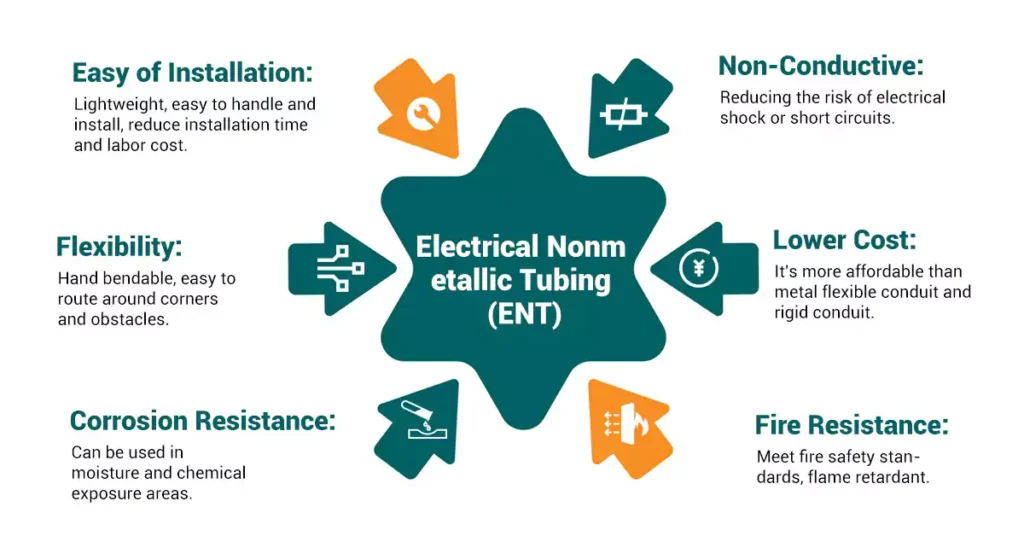
Léger et facile à installer :
ENT is significantly lighter than metallic conduits, making it easy to handle and install. This can reduce labor costs and installation time, especially in large-scale projects.
- La flexibilité:
Its inherent flexibility allows ENT to be routed around obstacles without the need for complex fittings or jointing, simplifying the installation process and reducing material costs.
- Résistance à la corrosion:
ENT is highly resistant to corrosion, making it an excellent choice for environments prone to moisture or chemical exposure, such as basements and coastal areas.
- Non-Conductive Properties:
As a non-metallic conduit, ENT does not conduct electricity, providing a safer option by reducing the risk of electrical shock or short circuits in case of wire damage.
- Lower Cost:
ENT is generally more affordable than rigid metal conduit (RMC) or intermediate metal conduit (IMC), making it an economical solution for standard electrical installations.
- Résistance au feu:
ENT can meet fire safety standards when properly rated, providing flame-retardant properties that enhance safety in case of a fire.
Lower Mechanical Strength:
ENT is not as robust as metallic conduits, making it less suitable for applications where high mechanical strength is required, such as in areas with potential for heavy impact or compression.
- Limited Temperature Tolerance:
ENT may have reduced performance at high or low temperatures. It can become brittle in extremely cold environments or warp under intense heat unless specifically designed for such conditions.
- UV Sensitivity:
ENT may degrade over time when exposed to direct sunlight unless treated with UV stabilizers. This limits its use in outdoor installations without additional protective measures.
- Not Suitable for Certain Environments:
In some high-stress or industrial applications where fire hazards or exposure to chemicals that can degrade plastic exist, ENT might not meet the necessary safety and durability standards.
- Support and Installation Requirements:
ENT must be properly supported throughout its length to prevent sagging or damage over time. This can add to the installation complexity, especially when long runs are needed.
Electrical Nonmetallic Tubing offers a flexible, cost-effective, and corrosion-resistant solution for many electrical installation needs. However, it is essential to consider its limitations, particularly in terms of mechanical strength and environmental exposure, to ensure its suitability for a given application. Understanding these pros and cons helps in making informed decisions about when and where to use ENT in electrical projects.
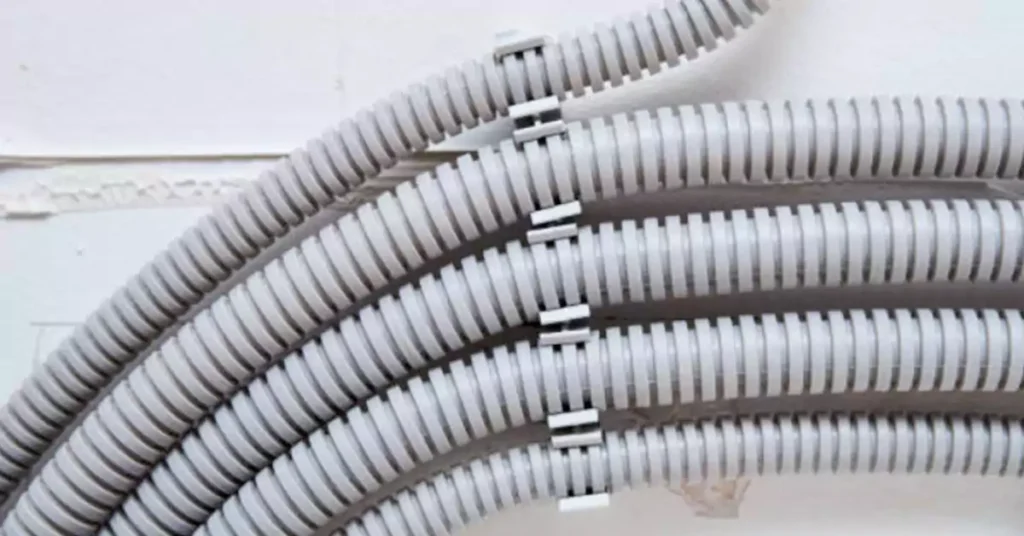
Installing electrical nonmetallic tubing requires careful planning and execution to ensure proper protection and functionality of electrical wiring. The National Electrical Conduit (NEC) has outlined the guidelines of installations for ENT, the process is generally straightforward, involving a series of preparatory and installation steps. Here are the general installation steps:
There are 8 steps to install the ENT tubing:
- Plan the Installation Path: Identify and mark the route for the conduit.
- Cut the Tubing: Measure and cut ENT to the desired length using a conduit cutter or fine-toothed saw.
- Deburr the Ends: Smooth any rough edges at the cut ends to prevent damage to the wiring.
- Connect Fittings and Couplings: Attach fittings to connect ENT segments and ensure a secure connection.
- Position and Secure the ENT: Place the tubing along the planned path and secure it with clamps or brackets at regular intervals.
- Pull the Wires : Use a fish tape to pull the wires through the ENT, ensuring no sharp bends or kinks.
- Connect to Electrical Boxes: Securely connect the ENT to electrical boxes and enclosures.
- Inspect and Finalize Installation: Conduct a final inspection to check for proper support, secure fittings, and compliance with electrical codes.
There are 6 things you need to know before installation:
Support et espacement : Ensure that ENT is supported at regular intervals, typically no more than 3 feet apart, to prevent sagging or stress on the tubing.
Avoid Sharp Bends: Avoid excessive bending of the tubing, which can restrict wire movement and cause damage. Use fittings designed for turns when necessary.
Considérations relatives à la température : Do not install ENT in temperatures below its rated minimum or in areas where it will be exposed to extreme heat without proper thermal protection.
UV Exposure: For outdoor installations, confirm that the tubing is rated for UV exposure or take additional protective measures such as placing it under a cover.
Secure Fittings Properly: Use approved fittings and connectors to secure ENT to electrical boxes or junctions. Improperly attached fittings can lead to conduit disconnection and electrical hazards.
Verify Code Compliance: Always ensure that the installation meets local electrical code requirements, which may specify additional guidelines for conduit placement, wire capacity, and connection methods.
By following these installation steps and precautions, electricians and installers can achieve a secure and reliable ENT installation that meets safety and performance standards.
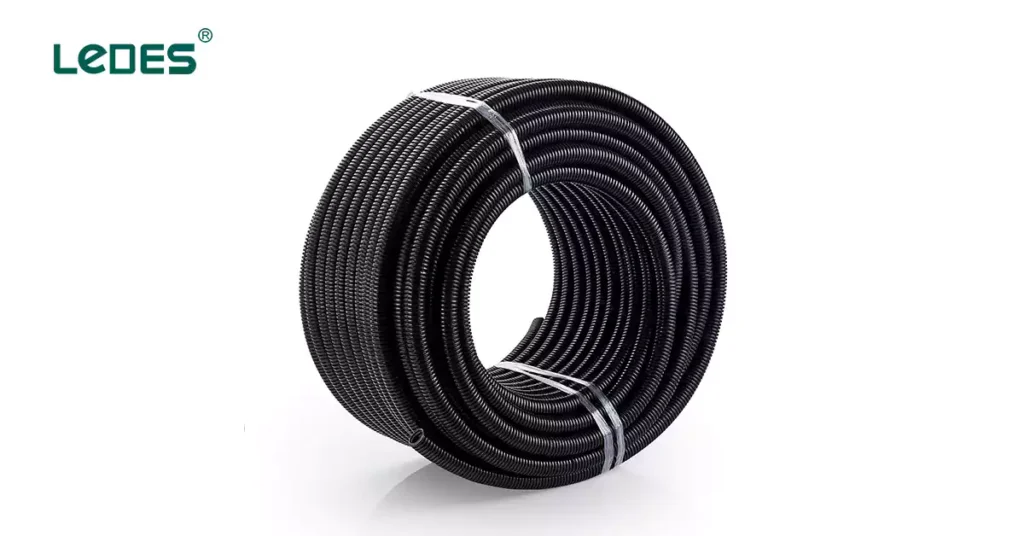
There are 6 tips for buying electrical nonmetallic tubing,
- Understand the Application:
Indoor or Outdoor Use: Make sure the ENT is rated for the environment where it will be installed, such as dry, wet, or outdoor spaces.
Wire Capacity: Choose the right size based on how many wires need to be protected.
- Check the Material and Ratings:
Quality of Plastic: Look for ENT made of strong, durable plastic that can resist fire and chemicals.
Standards Compliance: Make sure the product meets industry standards like UL (U.S.) or AS/NZS (Australia/New Zealand).
- Consider Flexibility and Installation:
Pick ENT that is flexible enough to go around obstacles but still sturdy.
Ensure it’s easy to cut and work with using standard tools.
- Look for Durability:
Impact Resistance: Choose tubing that won’t easily crack or dent.
UV Protection: For outdoor use, make sure it’s protected against sun damage.
- Balance Cost and Quality:
Don’t just go for the cheapest option. Higher-quality ENT often lasts longer and performs better, which can save money over time.
- Check Compatibility:
Make sure the ENT can be used with standard fittings and connectors.
The future of Electrical Nonmetallic Tubing (ENT) is set to expand into areas that support sustainability and smart technologies. Here are some key trends:
- Renewable Energy Systems
ENT is expected to play a bigger role in renewable energy installations, such as solar and wind power systems. These setups often require flexible, non-corrosive conduits that can withstand various weather conditions. ENT’s lightweight and corrosion-resistant properties make it ideal for routing cables in solar farms and wind turbine installations, contributing to cleaner energy infrastructure.
- Green Building Construction
As construction shifts towards greener practices, ENT will be increasingly used in eco-friendly buildings. Sustainable buildings aim to reduce environmental impact and improve energy efficiency, and ENT fits well in these designs due to its recyclable material options and lower overall environmental footprint compared to metal conduits.
- Smart Homes and IoT Integration
ENT is likely to see more use in smart home systems where extensive wiring is needed for sensors, automation controls, and IoT devices. Its flexibility and ease of installation make it a practical choice for accommodating complex wiring setups in homes that incorporate smart technologies.
- Electric Vehicle (EV) Infrastructure
With the growth of electric vehicle charging stations, ENT can serve as a conduit solution for routing power and data cables. Its adaptability and durability help support both indoor and outdoor charging stations, facilitating the expansion of EV infrastructure that is crucial for sustainable transportation.
- Smart Grids and Power Management Systems
ENT’s role may expand in the development of smart grids, which require extensive wiring for data communication and power distribution. These systems rely on real-time data to optimize energy use and improve reliability. ENT’s potential integration with monitoring technologies could help improve the efficiency and manageability of such smart power systems.
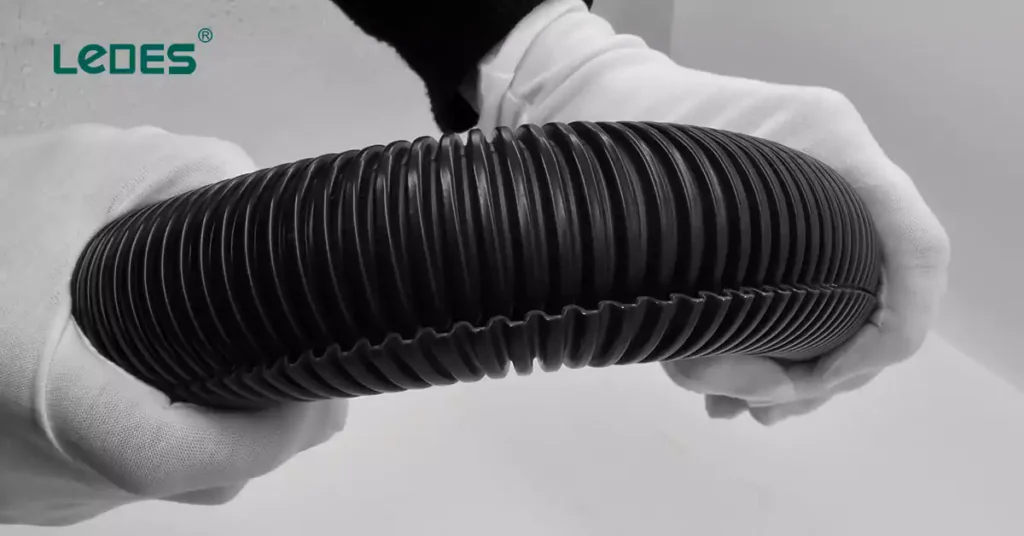
The use of Electrical Nonmetallic Tubing (ENT) and other conduits in the electric vehicle (EV) and automotive industries is a rapidly growing area, as these industries adopt more advanced electrical systems. Here’s a closer look at how ENT and similar conduits are being used and their future potential:
- Electric Vehicle (EV) Charging Infrastructure
With the increase in electric vehicle adoption, EV charging stations are becoming more widespread, requiring robust and flexible conduit solutions. ENT and other conduits are used for:
Protection des câbles : ENT is ideal for protecting charging cables from physical damage and environmental factors. The tubing ensures the safe routing of cables from the power supply to the charging point.
Outdoor Durability: ENT’s weather-resistant qualities make it suitable for both indoor and outdoor installations, as charging stations often need to withstand harsh environmental conditions such as rain, snow, and UV exposure.
Data and Power Cable Management: For advanced charging stations with smart capabilities (e.g., energy monitoring, payment systems), ENT can protect both the power and data cables that are required for the system to function efficiently.
- Electric Vehicle Wiring Systems
Electric vehicles require extensive electrical wiring for various systems, including the battery management system, motors, charging systems, and sensors. Conduits like ENT are used to:
Cable Routing: ENT is used to route wires in the car’s body, ensuring that sensitive wiring is protected from physical stress, moisture, and temperature fluctuations.
La flexibilité: The flexibility of ENT allows it to be installed in tight spaces within EVs, such as around motors, batteries, and other critical components. This flexibility helps streamline the assembly process and ensure safety.
Thermal Protection: ENT’s resistance to heat makes it suitable for managing the heat generated by power cables or components in high-performance EVs.
- Automotive Manufacturing
In the automotive industry, conduit systems are essential for organizing and protecting cables that power vehicle electronics. ENT and other conduits help in:
Protection During Manufacturing: ENT protects wiring from potential damage during the manufacturing process, including paint application, mechanical assembly, and other stages.
Flexible Wiring: For complex wiring systems in modern vehicles, ENT’s flexibility allows it to be easily routed through different sections of the vehicle, providing protection against abrasion, cuts, and environmental exposure.
- Systèmes de stockage de batteries
As more companies develop energy storage systems for EVs and other renewable energy projects, ENT can play a role in ensuring that the battery systems are properly wired and shielded. ENT is used to route electrical wiring from the batteries to various components, ensuring that these systems remain safe, reliable, and efficient.
- Smart Vehicles and Autonomous Cars
With the development of smart vehicles and autonomous driving technology, the need for reliable and durable electrical systems has skyrocketed. ENT plays a role in:
Data Cable Protection: Autonomous vehicles rely heavily on sensors, cameras, and other connected systems that generate vast amounts of data. ENT can protect the data cables that carry signals from these systems to the vehicle’s central processing units.
Low-Voltage Wiring: As vehicles become more automated and include systems for driver assistance, comfort, and entertainment, ENT is used to protect low-voltage wiring that powers these systems.
Understanding the fundamentals of Electrical Nonmetallic Tubing (ENT) is essential for industry professionals seeking reliable, flexible, and efficient solutions for electrical installations. ENT tubing serves a critical role in both residential and commercial applications due to its lightweight nature, ease of installation, and adaptability.
In this overview, we explored the main types of ENT, their respective uses, and the performance attributes that make them suitable for various environments. Compliance with codes such as UL 1653 and AS/NZS 2053 underscores the importance of meeting stringent safety and performance standards, ensuring that ENT remains a dependable choice even under challenging conditions.
Staying informed on the latest standards and advancements ensures that electrical professionals can leverage the full benefits of ENT tubing, optimizing both safety and efficiency in their projects. And evaluate the project needs before you choose the tubing types, making sure you choose the right one and comply with your local codes.



